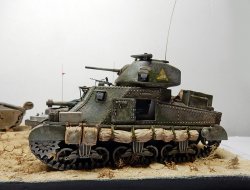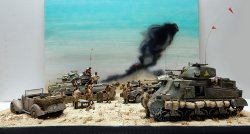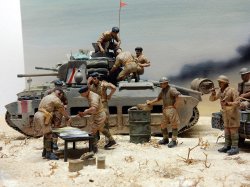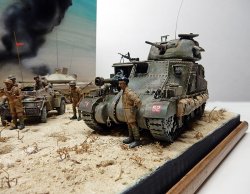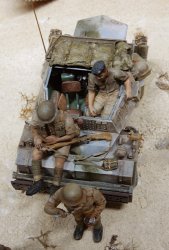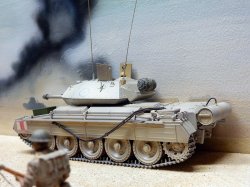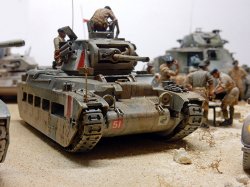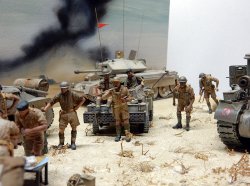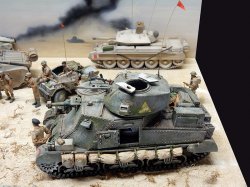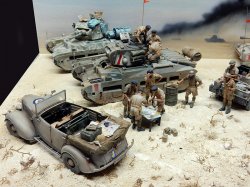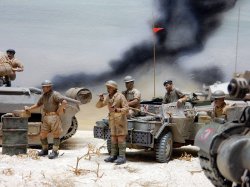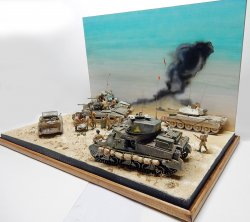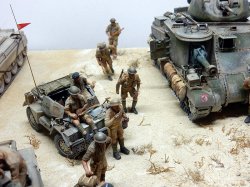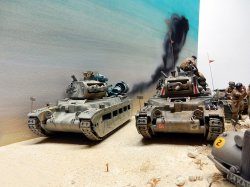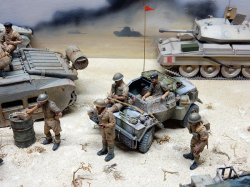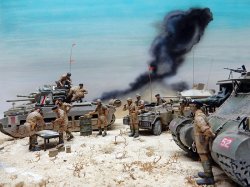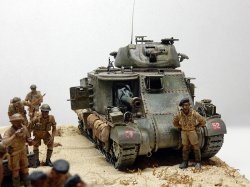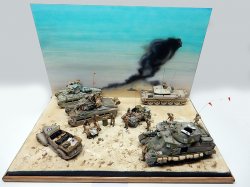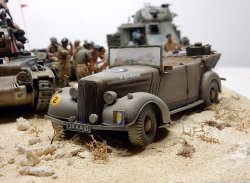
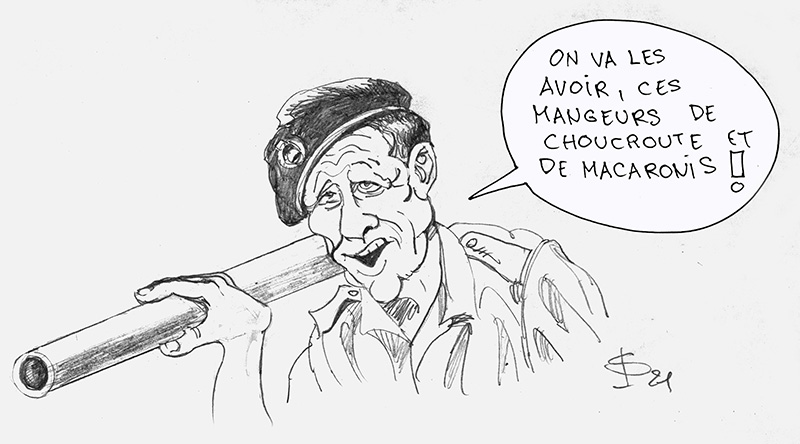
"We're going to get those sauerkraut and macaroni eaters! "
La bataille de Gazala mai 1942.
La plus grande bataille de l’Africakorps en Cyrénaïque avant la prise de Tobrouk. Mais Rommel n’est pas passé loin de la catastrophe. Pertes importantes des deux côtés. En une matinée, Rommel détruit une brigade motorisée, en repousse trois autres dont deux blindées, et décapite la 7th Armoured Division (capturant l’état-major avec ses codes). Puis le D.A.K. va subir l’attaque concentrique de trois brigades blindées en même temps. Les pertes des deux camps sont sévères (Le 3rd Royal Tank Regiment au soir du 27 mai n’a plus que 5 Grant et 8 Stuart) mais la position des unités italo-allemandes est mauvaise au soir de la première journée de combats.
Le maréchal Auchinleck va commander la 8th Army de juillet 1941 à août 1942, où il est limogé par Churchill et remplacé par Alexander et Montgomery à partir du 11 août.
Les combats commencent le 26 mai avec l’opération « Venezia », offensive de la Panzer Afrika sur la ligne Gazala. 400 chars anglais seront perdus (sur 650 à 700) dont la plupart des Grant.
La bataille de Gazala est une victoire « à l’arraché », les troupes de l’Axe amenées par un Rommel maîtrisant admirablement bien les opérations complexes et fluides dans le désert.
Auchinleck et Ritchie rameutent de toutes parts les forces pour barrer l’accès à la frontière égyptienne, tout en laissant Tobrouk isolée…
Les forces blindées de la 8th Army sont laminées, vaincues. Pas d’appui ni coordination pour les tankistes britanniques (artillerie, escorte d’infanterie) face à l’artillerie italo-allemande dont les terribles canons de 88. Mauvaise cohésion au combat des Grant. Positions non concentrées, trop disséminées. Suite aux pertes importantes, les unités blindées seront amalgamées les unes aux autres, privant les hommes de cohésion et d’esprit de corps.
Les tankistes de la 8th Army accumuleront défaites et déboires jusqu’à El Alamein. Auchinleck, faisant un peu trop confiance à son état-major, aurait dû être sur le terrain dès le début…
. 2 juin 1942 : Le 5th Royal Tank Regiment perd 20 Grant. Il lui en reste 3 dans la soirée…
- 5 juin 1942 : La 22nd Armoured Brigade perd une soixantaine de chars sur les 156 du matin…
- 12 juin : La 4th Armoured Brigade bien que loin des combats n’a plus que 4 Grant.
- 13 juin : La 22nd Armoured Brigade et la 32nd Army Tank Brigade, réduites à une cinquantaine de Grant, Crusader, Valentine et Matilda résistent jusqu’au 14… Ce qui implique pour les britanniques la retraite vers la frontière égyptienne.
- Quant à la 2th Armoured Brigade, elle est hors d’atteinte.
La supériorité numérique en artillerie et le savoir-faire quant aux manœuvres interarmes des allemands ont pleinement joué… Dans le désert, la décision repose moins sur les chars, que sur les canons (y compris ceux des chars). Rommel s’emparera de Tobrouk le 21 juin.
Le diorama
Les engins disponibles se rassemblent à EL Adem pour être pris en compte par la 4th Armoured Brigade. 59 chars dont : 23 Grant, 12 Crusader, 24 Stuart.
Le GRANT : char LEE, fabriqué aux U.S.A en 2000 exemplaires. 28 tonnes. Deux canons de 75 et 37mm. 6 hommes d’équipage.
Début 1942, la 8th Army reçoit ses premiers chars américains – en fait des Lee – à coque riveté (fortement inspirés des B1 BIS français pour l’armement).
Mécontents de la tourelle trop haute, les anglais la change pour une version plus basse et plus large pour y loger un poste de radio. Comme le char français, le canon de 75mm sur le côté droit réduit l’angle de tir, et oblige le char à tourner pour se positionner d’où perte de temps… Il sera détrôné à El Alamein par le Sherman.
Les allemands découvrent le Grant, mais le sous-estime suite à l’interception de rapports critiques britanniques. Les Panzers III vont rarement se heurter de front aux Grant, laissant les canons de 88mm fixer les engins ennemis pour mieux les tourner et les attaquer de flanc, voire, par l’arrière. Tactique qui portera ses fruits…
C’est le chant du cygne pour le Matilda II remplacé par le Valentine (qui ne vaut guère mieux), faible armement, faible blindage… Idem pour le Crusader qui a la vitesse pour lui… Bientôt, les premiers Churchill arriveront sur le terrain à El Alamein…
The Battle of Gazala May 1942.
The Africakorps' biggest battle in Cyrenaica before the capture of Tobruk. But Rommel was not far from disaster. Heavy losses on both sides. In one morning, Rommel destroyed a motorized brigade, repulsed three others, including two armored ones, and decapitated the 7th Armored Division (capturing the headquarters and its codes). The D.A.K. was then subjected to a concentric attack by three armoured brigades at the same time. Losses on both sides were severe (on the evening of May 27, the 3rd Royal Tank Regiment had only 5 Grants and 8 Stuarts left), but the position of the Italo-German units was poor on the evening of the first day of fighting.
Field Marshal Auchinleck commanded the 8th Army from July 1941 to August 1942, when he was dismissed by Churchill and replaced by Alexander and Montgomery from August 11.
The fighting began on May 26 with Operation Venezia, a Panzer Afrika offensive on the Gazala line. 400 British tanks were lost (out of 650 to 700), most of them Grants.
The Battle of Gazala was a "hard-fought" victory, as the Axis troops led by Rommel admirably mastered complex, fluid desert operations.
Auchinleck and Ritchie gathered forces from all sides to block access to the Egyptian border, leaving Tobruk isolated...
The armored forces of the 8th Army were crushed and defeated. No support or coordination for British tankers (artillery, infantry escort) in the face of Italo-German artillery, including the terrible 88 mm guns. Poor cohesion in battle for the Grants. Positions not concentrated, too scattered. Following heavy losses, the armored units were amalgamated, depriving the men of cohesion and esprit de corps.
The tankers of the 8th Army suffered a series of defeats and setbacks right up to El Alamein. Auchinleck, a little too confident in his staff, should have been in the field from the start...
. June 2, 1942: The 5th Royal Tank Regiment loses 20 Grants. It has 3 left in the evening...
June 5, 1942: The 22nd Armoured Brigade loses some 60 tanks out of the 156 it lost in the morning...
June 12: The 4th Armoured Brigade, although far from the fighting, has only 4 Grants left.
June 13: The 22nd Armoured Brigade and the 32nd Army Tank Brigade, reduced to around 50 Grant, Crusader, Valentine and Matilda tanks, hold out until the 14th... which means that the British must retreat to the Egyptian border.
As for the 2nd Armoured Brigade, it was out of reach.
The Germans' numerical superiority in terms of artillery and their know-how in terms of inter-army maneuvers came into full play... In the desert, the decision rests less on tanks than on guns (including tank guns). Rommel captured Tobruk on June 21.
The diorama
The available equipment assembles at EL Adem for consideration by the 4th Armoured Brigade. 59 tanks including: 23 Grant, 12 Crusader, 24 Stuart.
The GRANT: LEE tank, manufactured in the U.S.A. in 2,000 units. 28 tons. Two 75mm and 37mm guns. 6-man crew.
At the beginning of 1942, the 8th Army received its first American tanks - in fact Lee tanks - with riveted hulls (strongly inspired by the French B1 BIS in terms of armament).
Dissatisfied with the high turret, the British changed it for a lower, wider version to accommodate a radio. Like the French tank, the 75mm gun on the right-hand side reduces the angle of fire, and forces the tank to turn to position itself, wasting time... It was dethroned at El Alamein by the Sherman.
The Germans discovered the Grant, but underestimated it by intercepting critical British reports. The Panzer IIIs rarely came up against the Grant head-on, leaving the 88mm cannons to fix the enemy's engines, the better to turn and attack them from the flank, or even from behind. A tactic that paid off...
This was the swan song for the Matilda II, replaced by the Valentine (which was no better), with its poor armament and weak armor... Ditto for the Crusader, which had speed on its side... Soon, the first Churchills would arrive in the field at El Alamein...















